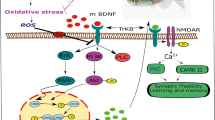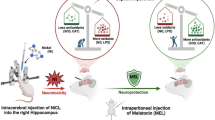Abstract
Objective
To determine the effects of 5-hydroxymethyl furfural (5-HMF), an extract of Rehmannia glutinosa Libosch, on several down-regulated signaling molecules involved in learning and memory in hippocampal neurons.
Methods
After cultured for 7 days, primary hippocampal neurons were divided into 5 groups: normal, corticosterone model, RU38486, 5-HMF, and donepezil group. Neuron survival rates were calculated 24 h later using SYTO13-PI double-fluorescence staining and an 3-(4,5-Dimethylthiazol-2-yl)-2,5-diphenyltetrazolium bromide (MTT) assay. β-galactosidase activity was also assayed. Protein expressed by the glucocorticoid receptor (GCR), brainderived neurotrophic factor (BDNF), and N-methyl-D-aspartate receptor 2B (NR2B), as well as phosphorylationcyclic adenosine monophosphate (cAMP) response element binding protein (p-CREB), phosphorylation-extracellular signal-regulated kinase (p-ERK), and phosphorylation-synapsin (p-synapsin) were quantified with Western blot.
Results
Hippocampal neuron survival rates and the above-mentioned proteins were dramatically decreased (P<0.05), β-galactosidase activity was significantly increased in the model group. but the effect was reversed by 5-HMF, RU38486, and to a lesser extent by donepezil (P<0.05).
Conclusion
5-HMF extracts from the Chinese herb Rehmannia glutinosa Libosch could protect hippocampal neurons from glucocorticoid injury and from down-regulated signaling molecules in the GCR-BDNF-NR2B-p-ERK-p-CREB-p-synapsin signal transduction pathway.
Similar content being viewed by others
References
Cui Y, Yan ZH, Hou SL, Chang ZF. Effect of Shudihuang on the transmitter and receptor of amino acid in brain and learning and memory of dementia model. China J Chin Mater Med (chin) 2003;28:862–866.
Zhu MF, Liu XQ, Ju-hee O, Chang-soo Y, Je-Hyun L. Effect of concentration of catalpol and 5-hydroxymethyl-2-furaldehyde from processing of Rehmanniae Radix. China J Chin Mater Med (chin) 2007;32:1155–1157.
Sun G, Wan SL, Qiu J. New aspects of the mechanisms of glucocorticoid actions on the brain. Chin J Neurosci (chin) 2001;17:149–152.
Song LN. Effects of retinoic acid and its dexamethasone on proliferation, differentiation and glucocorticoid receptor expression in cultured human osteosarcoma cells. Oncol Res 1994;6:111–114.
Wu XL, Zhang WG, Shi XM, An P, Sun WS, Qiao CL, et al. Effect of artemisinin combined with glucocorticoid on the expressions of glucocorticoid receptor α mRNA, glucocorticoid receptor β mRNA and P300/CBP protein in lupus nephritis mice. Chin J Integr Med 2011;17:277–282.
Boyer P. Do anxiety and depression have a common pathophysiological mechanism? Acta Psychiatr Scand 2000;102:24–29.
Lynch MA. Age related impairment in long-term potentiation in hippocampus: a role for the cytokine, interleukin 1β. Prog Neurobiol 1998;56:571–589.
Murer MG, Yan Q, Raisman VR. Brain-derived neurotrophic factor in the control human brain and in Alzheimer’s disease and Parkinson’s disease. Prog Neurobiol 2001;63(85):71–124.
Wang YZ, Kou S, Gu LY, Zheng Q, Li M, Qi F, et al. Effects of Zuogui Pill and Yougui Pill on the expression of brain-derived neurotrophic factor and cyclic adenosine monophosphate/protein kinase a signaling transduction pathways of axonal regeneration in model rats with experimental autoimmune encephalomyelitis. Chin J Integr Med 2014:20:24–30.
Pang P, Lu B. Regulation of late-phase LTP and long-term memory in normal and aging hippocampus: role of secreted proteins tPA and BDNF. Ageing Rres Rrev 2004;3:407–430.
Sugimoto T, Kuroda H, Horii Y, Moritake H, Tanaka T, Hattori S. Signal transduction pathways through TRK-A and TRK-B receptors in human neuroblast-oma cells. J Cancer Res 2001;92:152–160.
Feng H, Lu LM, Huang Y, Zhu YC, Yao T. Blockage of NMDA receptor enhances corticosterone induced downregulation of brain derived neurotrophic factor gene expression in the rat hippocampus through cAMP response element binding protein pathway. Acta Physiologica Sinica 2005;57:537–544.
Schaaf MJ, de Jong J, de Kloet ER, Vreugdenhil E. Downregulation of BDNF mRNA and protein in the rat hippocampus by corticosterone. Brain Res 1998;813:112–120.
Hansson AC, Cintra A, Belluardo N, Sommer W, Bhatnagar M, Bader M, et al. Gluco- and mineralocorticoid receptor-mediated regulation of neurotrophic factor gene expression in the dorsal hippocampus and the neocortex of the rat. Eur J Neurosci 2000;12:2918–2934.
Angelucci F, Mathe A, Aloe L. Neurotrophic factors and CNS disorders: finding in rodent models of depression and schizophrenia. Pro Brain Res 2004;146:151–165.
Bliss TV. Yong receptors make smart mice. Nature 1999;40:25–27.
Eckles-Smith K, Clayton D, Bickford P, Browning MD. Caloric restriction prevents age-related deficits in LTP and in NMDA receptor expression. Mol Brain Res 2000;78:154–162.
Ferreira A, Rapoport M. The synapsins: beyond the regulation of neurotransmitter release. Cell Mol Life Sci 2002;59:589–595.
Hosaka M, Hammer RE, Sudhof TC. A phospho-switch controls the dynamic association of synapsins with synaptic vesicles. Neuron 1999;24:377–387.
Chen JJ, Yin DZ. A role of synapsin in the process of learning and memory. Chem Life 2006;26:334–336.
Chi P, Greengard P, Ryan TA. Synapsin dispersion and reclustering during synaptic activity. Nat Neurosci 2001;4:1187–1193.
Author information
Authors and Affiliations
Corresponding author
Additional information
Support by the National Natural Science Foundation of China (No. 30873317), the Leading Academic Discipline Project of Shanghai Municipal Education Commission (No. J50301), and Shanghai Health Bureau of Scientific Research Projects (No. 20124Y025)
Rights and permissions
About this article
Cite this article
Zhang, Ln., Jin, Gq., Zhang, Xl. et al. Effects of 5-hydroxymethyl furfural extracted from Rehmannia glutinosa Libosch on the expression of signaling molecules relevant to learning and memory among hippocampal neurons exposed to high concentration of corticosterone. Chin. J. Integr. Med. 20, 844–849 (2014). https://doi.org/10.1007/s11655-014-1830-6
Received:
Published:
Issue Date:
DOI: https://doi.org/10.1007/s11655-014-1830-6




